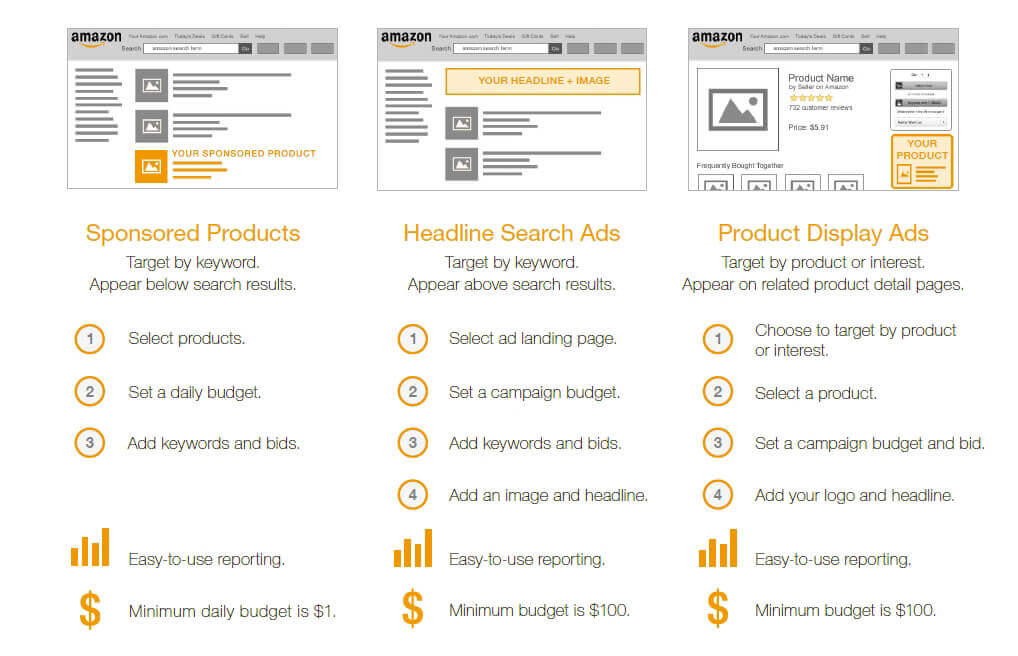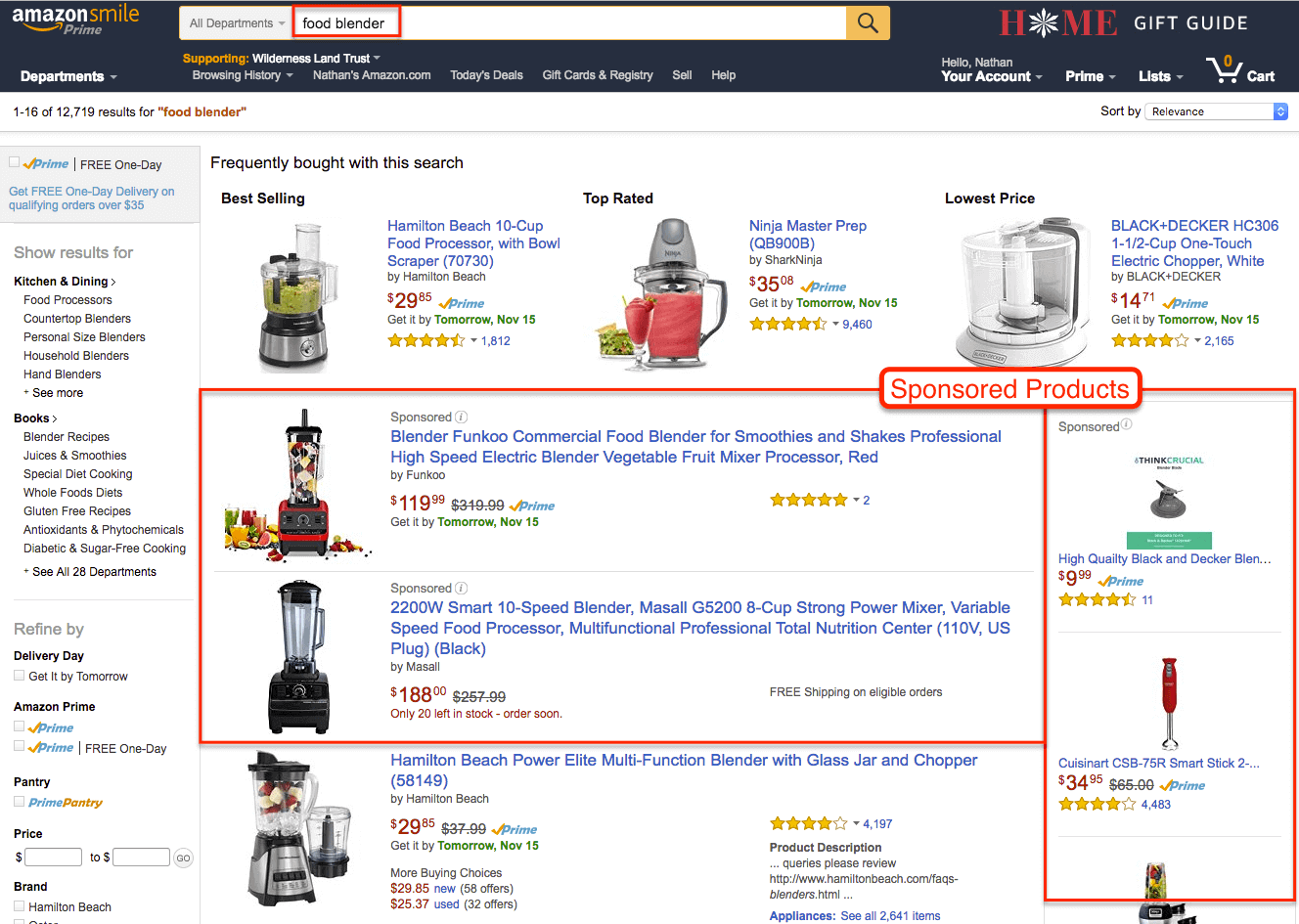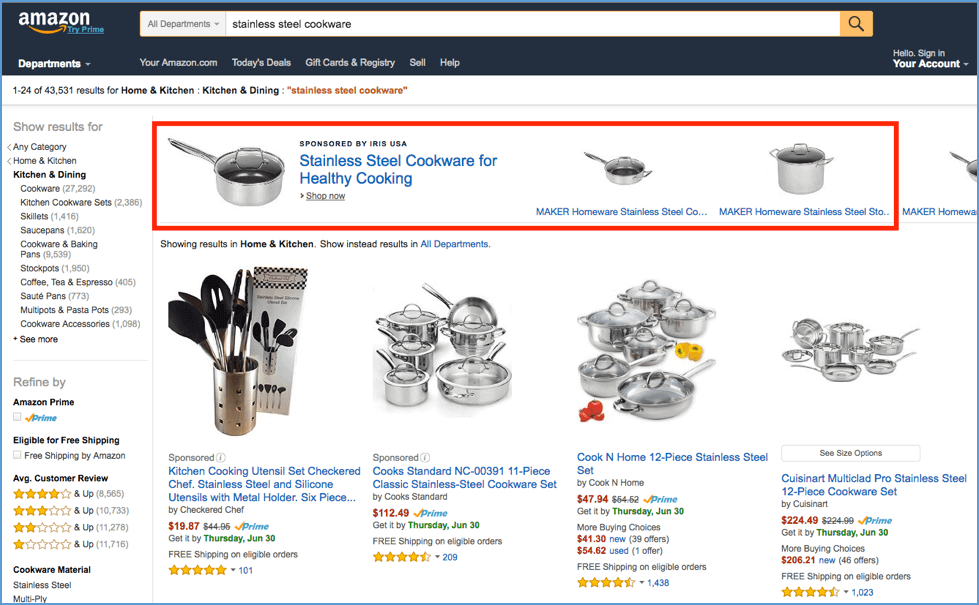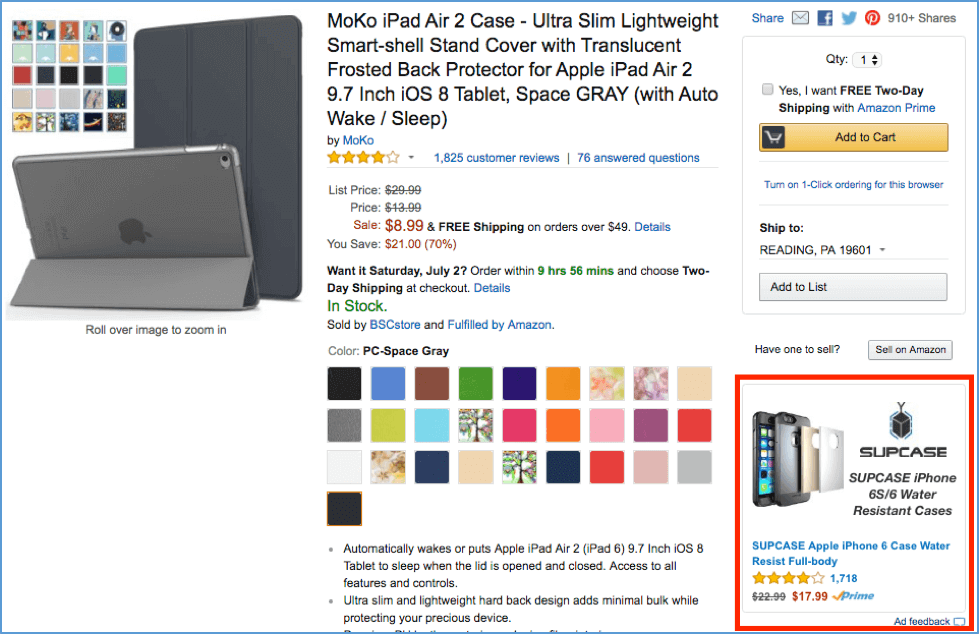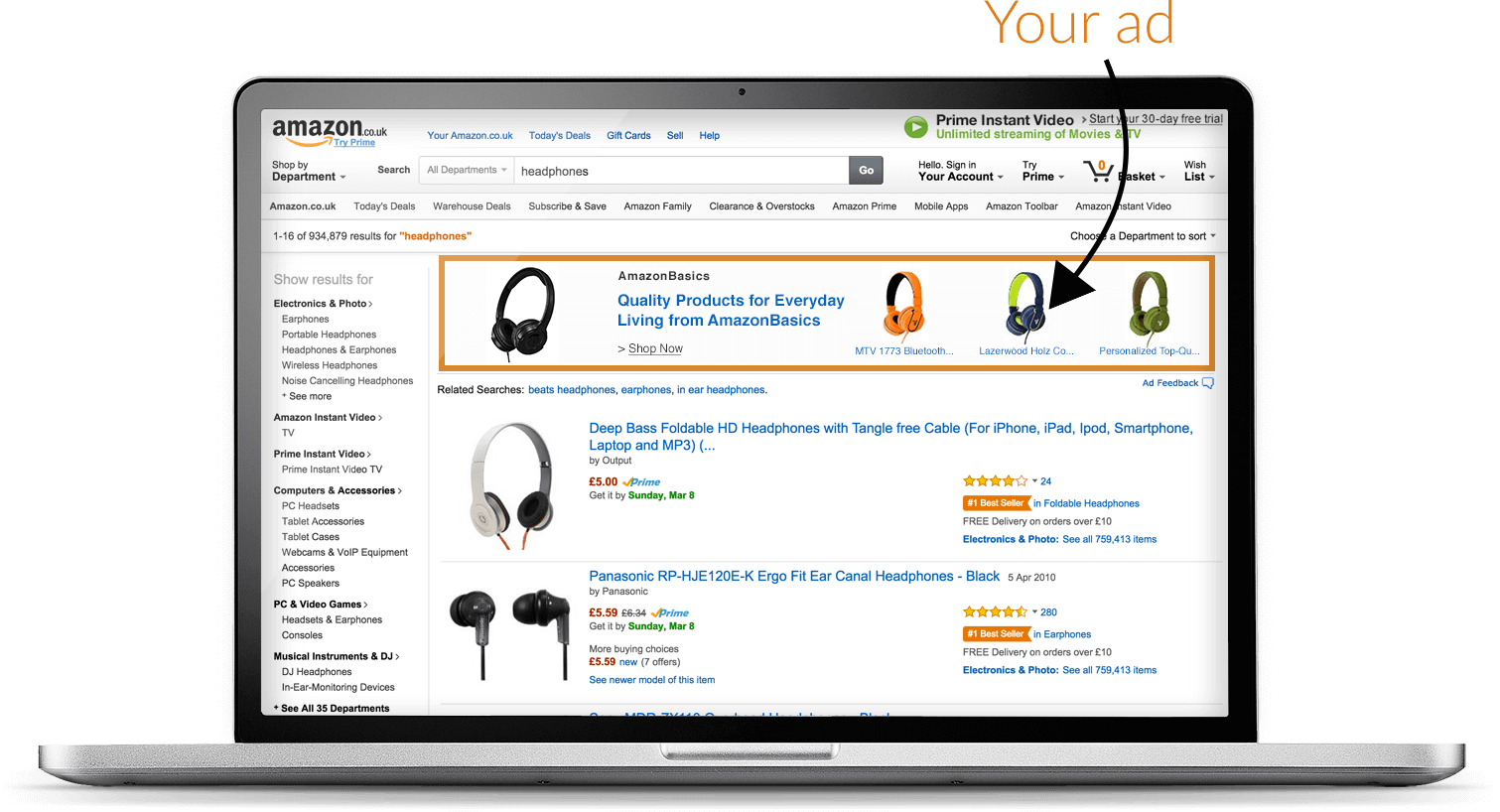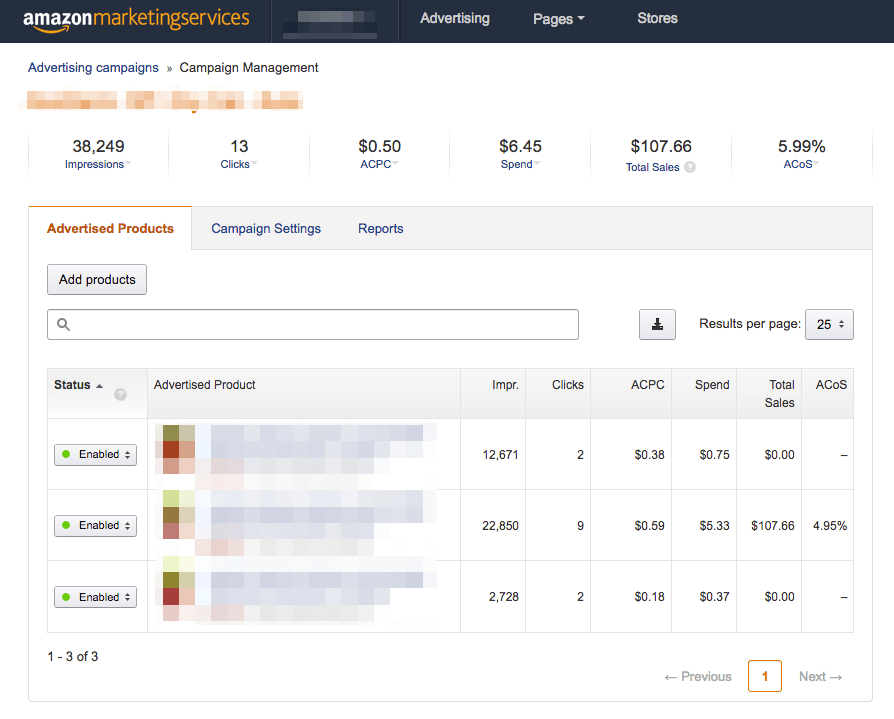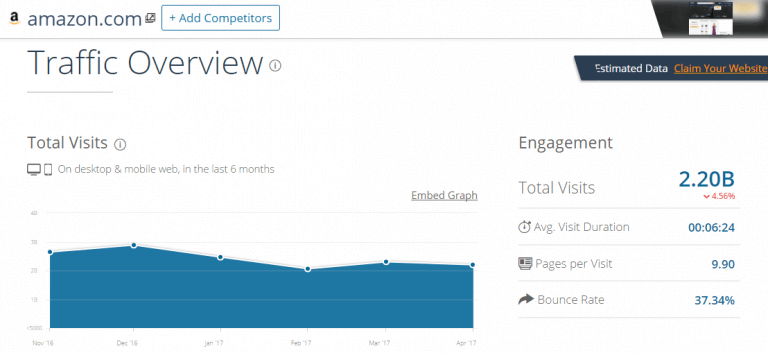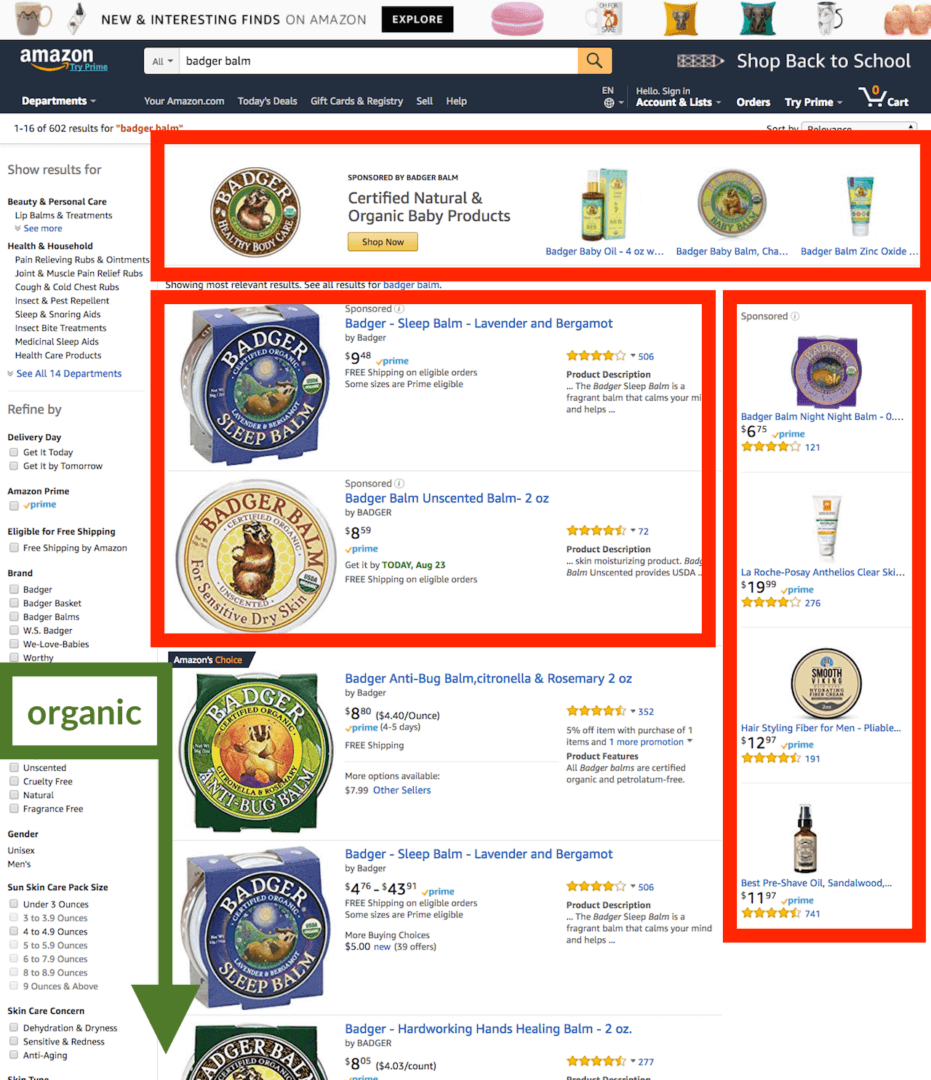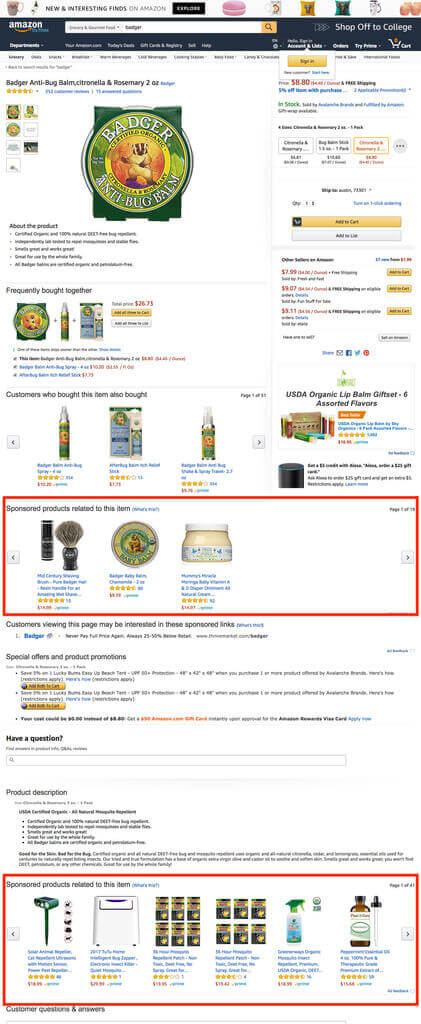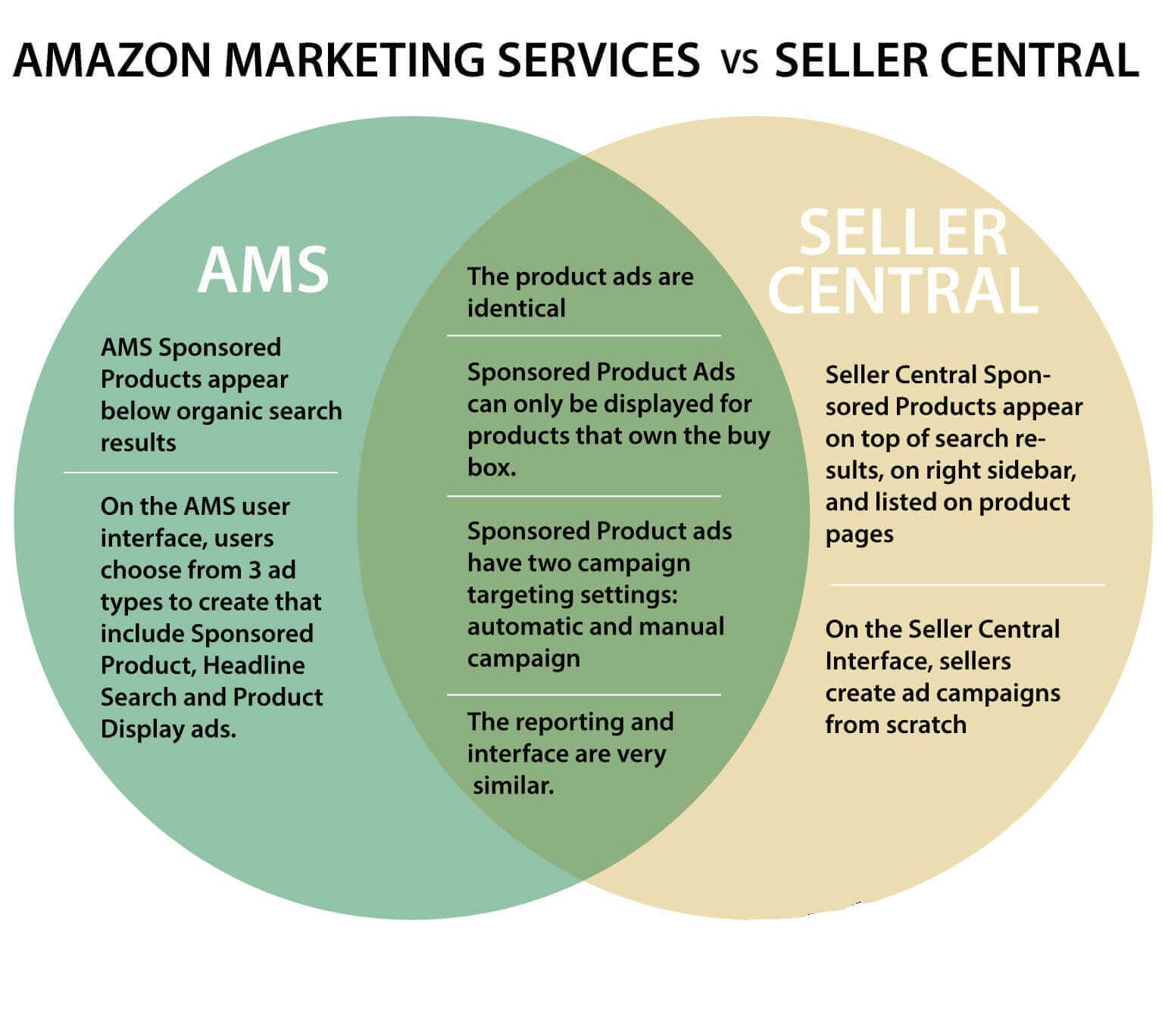Amazon Marketing Services (AMS) is a very lucrative and effective way for sellers to market their products directly to ‘open-wallet’ consumers. I say lucrative, as in the 3rd quarter of 2017, AMS reported a 58% year-over-year growth in ad sales which is the dollar equivalent of 1.12 Billion.
Beyond that, consider that $4 out of every $10 spent online is with Amazon!
These two statistics alone should be enough to help you grasp the power of Amazon Marketing Services as a tool, especially since Amazon as opposed to Google for example, knows exactly what consumers not only search for but also buy.
With that said, in this post I will cover:
- What Amazon Marketing Services is and how it works
- What tools are available to you through Amazon Marketing Services
- How Amazon Marketing Services compares with Sponsored Products
- What are some best practices to get top results with Amazon Marketing Services
What is Amazon Marketing Services ?
AMS or Amazon marketing services is a self-service platform which Amazon offers sellers in order to promote their products directly to their target market. AMS allows merchants to put ads in front of people who are ready to buy or who are ‘at the bottom of the conversion funnel’ – remember that people usually visit Amazon to make a purchase and not window shop!
Amazon Marketing Services allows sellers to market specific products with three unique options:
- Sponsored products
- Headline search ads
- Product display ads
Sponsored Products
Amazon will provide you with the most relevant and popular keywords current shoppers are using based on metadata they collect for your benefit.
- Ad location: Your ad will appear within the search results.
- The goal: To promote a specific product within search results in order to increase sales of said product.
- Minimum daily budget: $1
Headline Search Ads
This option is similar to the above ‘Sponsored Products’ but one of the key advantages and the reason why it is more expensive has to do with placement. Here your ad will appear above search results and not below them and will be larger.
- The goal: To drive traffic from search results pages to a page that shows a specific product or product range.
- Minimum daily budget: $100
Product Display Ads
Target potential customers based on products or interests – your ad will appear on pages which are similar or related to what you are selling based on what you choose. In the below example, a merchant has paid Amazon to place his or her iPhone case ad next to Apple related products such as this iPad Air case. This is based on the assumption that a person who is loyal to Apple will own more than one Apple product thus making them an ideal target customer.
- The goal: To increase visibility of your product towards the final stages of shopper conversion ie to try and divert customers from purchasing your competitor’s product and instead buy what you are selling.
- Minimum daily budget: $100
What are the advantages and disadvantages of Amazon Marketing Services ?
key advantages of Amazon marketing services
- Highly visible and targeted advertisements
2. Payment is only per click on your ad and not per impression
3. Access to real time advertising campaign data
4. The ability to optimize campaigns based on this data
5. Ad campaigns start at $1
6. The ability to constantly change your campaign’s budget
These are some serious advantages especially since many people using AMS report a 20-1 return on ad spending.
Disadvantages of Amazon marketing services
On the other hand AMS does have some disadvantages:
- Financial thresholds – This setback basically means that Amazon will not allow you to drive traffic to a product that is ‘too cheap’ for Amazon to make a profit off of. They have not published any official indications as to what this threshold is but it is something one should keep in mind – the lower the price of a product the likelier it will not meet Amazon’s threshold.
- Product segmentation – AMS has a real issue with product segmentation meaning if I put up an ad campaign for product A but you buy another one of my product’s, say B, many times this will affect the campaign data of product A. This can cause inaccuracies when assessing campaign success and planning campaign optimization.
- User Interface – or UI as it relates to AMS ads is considered by many as not up to par or being ‘10 years behind’ as far as the way these ads look and feel.
How Amazon Marketing Services compares with Sponsored Products (in Seller Central)
There is some confusion as to the differences and similarities between what is called AMS or Amazon Marketing Services and ‘Sponsored Products’. In this section of the post I will clear this up.
All Amazon sellers are eligible to create sponsored Product ads in Seller Central and this is actually one of the most popular types of product ads with sellers on Amazon. Additionally, it is the most prevalent type of Pay Per Click (PPC) when searching for products as a consumer on Amazon. If you have Vendor Central, you can also access Sponsored Product ads through Amazon Marketing Services.
Sponsored Products appear in one of two ways to consumers:
- Surrounding organic search results on three sides:
2. On product pages of similar products:
What are the similarities and differences between Sponsored Products (in Seller Central) and AMS ?
On the surface these two options seem almost identical and indeed they possess many similarities:
- To the naked eye these ads look identical and one cannot tell if this ad was placed by a third party vendor or not.
- Both have manual and automatic campaign options:
- Manual campaigns – this is when a seller manually selects and bids on keywords he or she wants to target in their advertising campaign
- Automatic campaigns – Here Amazon automatically reviews your product listing and bids on keywords for you automatically based on algorithms they have in place
- They both have feedback loops with dashboards to help you keep track of and optimize your ad campaigns.
The differences between Sponsored Products (in Seller Central) and AMS are:
- AMS as I showed above has 3 advertising options, one of which is ‘Sponsored Products’ – this option in AMS appears below organic search results in comparison with Seller Central Sponsored Products which appear:
- At the top of search results
- On the right of search results
- On product pages
- AMS users have three ad types to choose from:
- Sponsored Products
- Headline Search
- Product Display Ads
I am text block. Click edit button to change this text. Lorem ipsum dolor sit amet, consectetur adipiscing elit. Ut elit tellus, luctus nec ullamcorper mattis, pulvinar dapibus leo.
I am text block. Click edit button to change this text. Lorem ipsum dolor sit amet, consectetur adipiscing elit. Ut elit tellus, luctus nec ullamcorper mattis, pulvinar dapibus leo.
What are some best practices to get top results with Amazon Marketing Services
Now that you understand what Amazon Marketing Services is and how it compares with Sponsored Products, I would like to share with you best practices that you can apply today to your AMS campaigns in order to see top results:
Budget
All vendors and brands should have a clear monthly advertising budget for their campaigns on Amazon, be it $100 or $100,000. Once you have a clear budget you should decide how you will divide this budget up among the 3 core AMS advertising options. I recommend starting out by dividing it up as follows:
- 60% – Sponsored Products
- 30% – Headline Search
- 10% – Product Display Ads
This will give you coverage in all the different areas and allow you also to test the waters and optimize as the data rolls in. For example maybe the product you are selling is converting much more effectively using Headline Search ads and in that case you can make this your 60% and Sponsored Ads your 30%.
Product
Lay out a clear map of which products are a priority both for yourself as well as your customers. Advertising all of your products using an array of keywords very often may cause more chaos and harm than good. Try focusing on a specific product based on season such as swimwear in summer or based on demand such as Apple accessories directly after the release of a new Apple product.
Research
Do the proper research before spewing out your ads on AMS. Try to identify the best cross-selling opportunities such as selling suntan lotion next to bathing suits or screen protectors next to iPhones.
Research the high, medium and low search terms for your products including:
- Keywords
- Phrases
- Consumer interests
Doing this will help drive demand and raise awareness of your product. The reason why this step is crucial is because despite the fact that Amazon has algorithms which can help you choose keywords, many times it is worthwhile to ask friends and family which keywords they search for or to understand which products real shoppers have cross associations with. Computers can do many things today but there is no substitute for understanding human shopping behaviour and habits first hand.
Branding
Having a strong brand is key to your success on Amazon, as strong brands increase consumer confidence in products. AMS understands this and that is why they offer you the option to open an Amazon store for free! Once you are finished building your store, you are provided with a unique URL which you can link to through your ads. On this page you can offer:
- Product videos
- High quality images
- Detailed product explanations
Offering this level of professionalism to consumers sets you apart from your competition.
Synchronizing
It is recommended to synchronize all of your ad campaigns on Amazon Marketing services, especially if you have multiple campaigns and products being featured simultaneously. This is especially true during busy seasons such as holidays when traffic and orders can be at full capacity or beyond. You don’t want to compete against yourself in terms of ads and drive traffic away from one product of yours in favour of another. Timing is of the essence here!
Optimization
I mentioned this briefly in budgeting above. One of the fantastic tools you receive by using AMS is a feedback loop through statistics and data on your dashboard. Ask yourself the following questions and optimize your ad campaigns accordingly:
- Which ad type is performing best for which product ?
- Which products are performing best ?
- Which colors or models are performing best ?
- Which keywords are driving the most traffic and which are costing me money with little to show in return ?
- Which ad copy has the highest click-through rate ?
ACoS (Advertising Cost of Sales)
While following the quantity of clicks and impressions an ad generates, the single most important metric to follow in my opinion is the ACoS or Advertising Cost of Sales. This shows you the ratio of money you are spending on advertising a specific product as a ratio of the sales generated – the lower the percentage displayed, the better the campaign performance is. For example, if you are spending $100 on 2 ad campaigns per day and one has an ACoS ratio of 5% and the other 1% – it should be clear to you that the 1% ratio campaign is performing 5 times better. This means that for every hundred dollars you are spending, you are selling 5 as many products when compared with your secondary campaign.Follow ACoS carefully, weed out the golden eggs and double up your investment on them.
Summing it up
All in all AMS is a user friendly tool which allows you to increase sales significantly on Amazon and ultimately helps your bottom line. Despite some of the inconveniences, AMS is a fantastically powerful tool, which when used properly can provide you with product feedback and a unique opportunity to optimize your advertising campaigns on a regular basis. I invite you to start (or continue) planning your AMS strategy today and using the best practices I have provided you with in order to realize the full selling potential your products posses!




